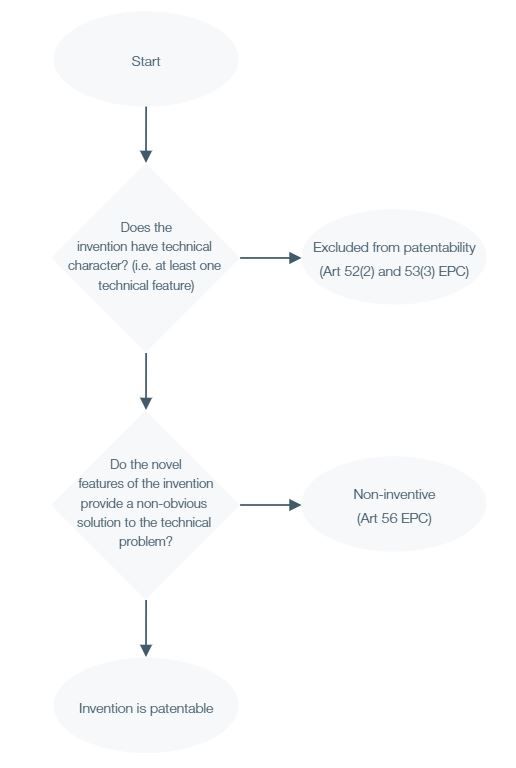In Europe, inventions that utilise distributed ledger technology will generally fall under the heading of "computer-implemented inventions (CIIs)." The EPO has an established body of case law for assessing the patentability of CIIS. When doing so, the EPO follows a two-step process, which can be understood with reference to the flow diagram below.

The first step in the process is to consider whether the claimed invention has technical character i.e. do the claims include any technical components, or is the invention solely an administrative or business process? In the absence of any technical features in the claims, the invention will be deemed to be excluded from patentability. Since any invention that makes use of a distributed ledger will, by its nature, utilise a computer or computer network, this hurdle can be overcome quite simply by making reference to this hardware in the claim, or in the case of a method, defining the method as a "computer-implemented" method.
Assuming that the claim defines at least one technical feature, the next step is to identify the novel features of the claim, and to assess whether or not those novel features together contribute to solving a technical problem, in a manner that is non-obvious from the prior art. This step may itself be broken down into several stages.
First, the Examiner will identify the "closest prior art" i.e. a single public disclosure that constitutes the most promising starting point for a development leading to the invention. The Examiner will then identify each difference between the invention and that prior disclosure, and consider which of those differences are technical in nature and which pertain to non-technical aspects such as business or administrative steps. The features that are identified as being both novel and technical in nature will then be used to determine the technical effect provided by the invention, and in turn formulate a technical problem that is solved by the invention. The final step is then to consider if the specific solution provided by the invention is one that would be obvious for a person of ordinary skill in the art to implement, based on what was known at the time the application was filed at the patent office.
For inventions that lie in the field of distributed ledger technology, the step of persuading the Examiner that the invention solves a technical problem – as opposed to an administrative or business-related problem – will often be critical. Therefore, when looking to pursue patent protection for inventions in this field, it is important to identify any specific technical advantages afforded by the invention, and to ensure the application is framed with these in mind.
What constitutes a technical problem for a DLT?
To understand what might constitute a technical effect in this field, it is helpful to class inventions into two categories. The first category includes inventions that enhance the underlying network and/or the way in which nodes in the network interact or communicate with one another. These might include protocols that help to circulate information more efficiently across the network, allowing nodes to update their copies of the ledger with new transactions as quickly as possible. Other inventions might help to reduce the overall energy required to record transactions in the ledger. Many distributed ledgers, for example, rely on the proof of work consensus algorithm for validating transactions; modifying the consensus algorithm or replacing it with a novel, more energy conservative algorithm, can be seen to provide a solution to the technical problem of reducing energy usage. Inventions in this first class of invention might generally be recognised as "application agnostic", in the sense that the function of the network / ledger is improved, regardless of any particular application that the distributed ledger is intended to be used for, be it storing of energy readings, health information, or facilitating payments or exchange of assets etc.
The second class of inventions will include those where a new use-case is proposed for a conventional distributed ledger platform. Examples might be where a DLT platform that had previously been used to effect payments in cryptocurrency is now used to record the transfer of a different type of asset. An invention could be born of the realisation that records stored in the ledger provide an effective means for supply chain monitoring, and not only financial transactions, for example.
The second class of inventions can sometimes pose more of a challenge for persuading the EPO that the invention solves a technical problem. Depending on the particular use-case, the EPO may view the core invention as being, at heart, an administrative or business process, rather than a technical one. For example, an application that suggested storing electrical meter readings from multiple users in a distributed ledger and using those readings to generate invoices for people's energy usage might face an inventive step objection, on the grounds that the invention is directed towards solving a business-related problem, rather than a technical one. Whilst the use of the distributed ledger would satisfy the requirement for a technical means, using the information stored in that ledger to calculate an amount to invoice a customer would not be deemed to solve a technical problem.
In practice, many inventions will have include elements from both categories above. A novel use-case for a distributed ledger may still require certain modifications be made to the underlying platform in order that the platform may then achieve the necessary functionality. As an example, using a conventional DLT platform to store and share a patient's healthcare data might not, by itself, be considered as solving a technical problem. However, by introducing additional functionality using smart contracts to identify attempts by unauthorised parties to access that data and alert the patient accordingly, a genuine technical contribution could be realised. Similarly, whilst inventions in the field of cryptocurrencies may, prima-facie, be concerned with business and financial aspects, a closer inspection may reveal a number of technical means for improving the scalability and throughput of transactions, as well as the security associated with those transactions and protection from malicious attacks. Such means, if captured properly in the patent application, can provide a strong basis for arguing the presence of a technical effect.
A key takeaway from this discussion is that when looking to patent an invention in this field, it is important to consider which aspects of the invention can be identified as solving a technical problem, and to frame the invention accordingly. Our experts are well placed to advise on which aspects are most likely to satisfy this requirement, and prepare the application accordingly, ensuring the best chance of a successful outcome at the patent office.
The content of this article is intended to provide a general guide to the subject matter. Specialist advice should be sought about your specific circumstances.

